 NonJet Movement.
NonJet Movement. 
The author of the article does not invent new physical laws, and in no case tries to violate the existing laws....
For the closed system, i.e., the system, which does not
experience external actions, or in the case, when the vector sum of those acting
on the system of external forces is equal to zero, occurs the law of
conservation of momentum. In this case the momentum of the individual parts of
the system (for example, under the action of internal forces) they can change,
but so that the value
 remains constant.
remains constant.
This law explains such phenomena as reactive motion, return
(or recoil) with the shot, work of screw propeller or oars, etc.
For example, if we consider gun and bullet as one system,
then the pressure of solid-reactant gases with the shot will be for this system
the force of internal and cannot change the momentum of system, equal to shot to
zero. Therefore, reporting to bullet the momentum
 , directed toward the muzzle end face, solid-reactant gases will report
simultaneously to gun numerically the same, but oppositely directed momentum
, directed toward the muzzle end face, solid-reactant gases will report
simultaneously to gun numerically the same, but oppositely directed momentum
 , which will cause return. From the equality
, which will cause return. From the equality
 (where
(where
 ,
,
 the numerical values of speeds) it is possible, knowing the speed
the numerical values of speeds) it is possible, knowing the speed
 of bullet with the departure from the stem, to find the maximum speed
of bullet with the departure from the stem, to find the maximum speed
 of return (but for the instrument - recoil).
of return (but for the instrument - recoil).
In the given example of body acquire the speeds under the
action of the power impulse
 , whose value is equal for both bodies, but it is opposite in the
direction (fig.1).
, whose value is equal for both bodies, but it is opposite in the
direction (fig.1).
They move rectilinearly and evenly after the action of the
power impulse of body.
The center of the masses (CM) of entire system, after the dispersion of
components, preserves its initial speed.
If we consider rocket and products of combustion of rocket
propellant as united mechanical system, then the center of the masses of this
system also keeps its position constant. (in the frame of reference, connected
with the launching point.)
The situation, when the components of the system of bodies
acquire momentum not due to the clearly expressed power impulse,
is at the same time possible.
Let us examine the following example.
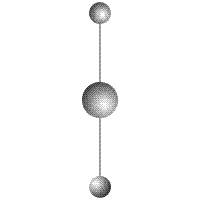
Fig. 2
Around the body by mass
 revolve two bodies of identical mass
revolve two bodies of identical mass
 (fig.2). All bodies are connected by rigid
indissoluble connections. Rotation with the angular velocity
(fig.2). All bodies are connected by rigid
indissoluble connections. Rotation with the angular velocity
 occurs around the overall center of the masses of system, which
coincides, in this case, with the center of the masses of body
occurs around the overall center of the masses of system, which
coincides, in this case, with the center of the masses of body
 . The system of bodies is balanced. Its center of masses is fixed. The
projections of momentum on the coordinate axis are equal to zero.
. The system of bodies is balanced. Its center of masses is fixed. The
projections of momentum on the coordinate axis are equal to zero.
If we at a certain moment of time tear one of the
connections, then the components of system will begin to be moved in opposite
directions.

Fig. 3
After the break of connection the system is decomposed into
two components: body
 and system of two connected bodies
and system of two connected bodies
 and
and
 (fig.3).
(fig.3).
Body
 will move rectilinear and it is even tangentially to the trajectory of
its motion at the moment of the break of connection.
will move rectilinear and it is even tangentially to the trajectory of
its motion at the moment of the break of connection.
The system of bodies

 will also move rectilinear and it is even. The momentum of this system, in
the absolute value, will be equal to momentum
will also move rectilinear and it is even. The momentum of this system, in
the absolute value, will be equal to momentum
 :
:

, where
 - the speed of the center of the masses of the system of bodies
- the speed of the center of the masses of the system of bodies
 and
and
 .
.
One should emphasize that the expression "is rectilinear and
evenly" it relates only to center the masses of the system in question
(it is noted by red color to
fig.3). The components of system, at the same time, acquire
the uneven relative speeds of displacement relative to the overall center of
masses.
If body
 at the initial moment of time, immediately after the break of connection,
moves just as body
at the initial moment of time, immediately after the break of connection,
moves just as body
 (in terms of the absolute value), then for the body
(in terms of the absolute value), then for the body
 the initial velocity is equal to zero.
the initial velocity is equal to zero.
Thus, body
 "is late", its speed noticeably lags behind the speed of the center of
masses at the initial moment of time, immediately after the break of connection.
It is possible to show only slow (fig.4).
"is late", its speed noticeably lags behind the speed of the center of
masses at the initial moment of time, immediately after the break of connection.
It is possible to show only slow (fig.4).
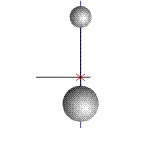
Fig. 4
This process of "delay" can be increased, "extended in the
time".
Let us assume on board a certain flight vehicle, which is
rested in weightlessness, is established the annular centrifuge, evenly filled
throughout entire circle with pellets. Rotary motion is given to centrifuge. The
axis of centrifuge coincides with the center of the masses of flight vehicle. At
a certain moment of time, pellet they begin to leave centrifuge. They leave
consecutively, after each other, from one and the same point, relative to the
housing of flight vehicle.
If pellets fired back how in an example with the gun and the
bullet, then after each shooting of pellet, the housing of flight vehicle would
acquire the pulse, equal in magnitude and opposite in the direction of fraction.
In the case with the centrifuge, there is no "shooting".
Pellet simply "is released", i.e., is broken the bond, due to
which the pellet accomplished rotary motion relative to the axis of centrifuge.
In the process of the department of pellets, the mass of load on the
centrifuge decreases. In this case the position of the center of the
masses of load changes.
In fig.5 is represented the graphic
version of the described process for the case with the centrifuge, which
contains 4 load- pellets.
It is assumed that the turning of entire system is absent. (let us assume on
board the flight vehicle they are established two identical centrifuges, which
revolve in the opposite sides.)
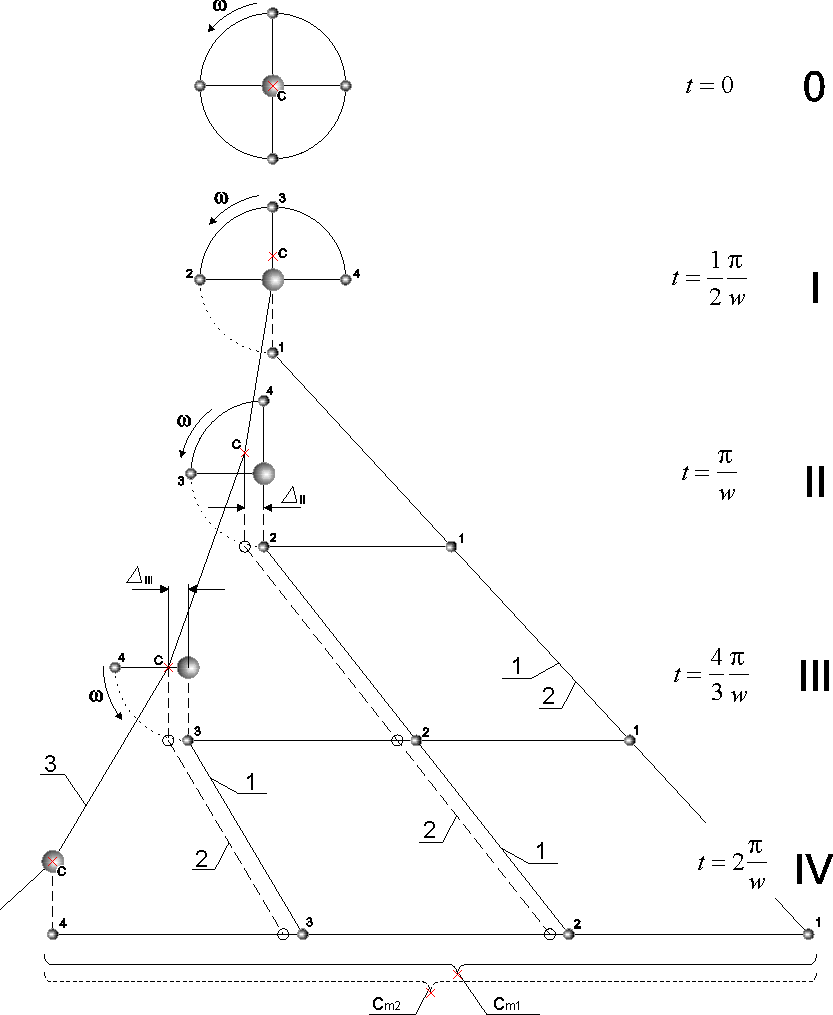
Fig. 5
At the initial moment 0 (fig.5) load are evenly distributed . Centrifuge is balanced and revolves with the angular
velocity  . The center of the masses of load (point"C") coincides with
the rotational axis of centrifuge and the center of the masses of the housing of
flight vehicle. . The center of the masses of load (point"C") coincides with
the rotational axis of centrifuge and the center of the masses of the housing of
flight vehicle.
After each department of pellet (moments I.II.III.IY in the
figure), the center of the masses of the housing of apparatus with the
unbalanced centrifuge move rectilinearly and evenly (broken line 3).
Pellets also move evenly and rectilinearly (straight lines
1).
But only first and latter of pellet (moments I and IY)
are separated from the center of the masses of system [ the housing of apparatus
+ centrifuge ] (in the projection on the axis of displacement of components).
At the moments of time the II and III loads are separated at
a certain distance
 from the center of the masses of system [ the housing of apparatus + the
unbalanced centrifuge ]. Occurs as the "delay" of the process of department.
"delay" from the uniform and rectilinear displacement CM.
from the center of the masses of system [ the housing of apparatus + the
unbalanced centrifuge ]. Occurs as the "delay" of the process of department.
"delay" from the uniform and rectilinear displacement CM.
For the comparison, figure gives the possible trajectories of
the motion of pellets in the case of their shooting from the center of the
masses of system [ housing + centrifuge ] (dotted lines 2 in the figure).
By "shooting", in this case, is implied the department of particles under the
action of the power impulse, after which the particles would acquire the same
relative speed as with separation from centrifuge. Each shooting of pellet would
be produced from the center of the masses of the housing of flight vehicle with
the load of the remained pellets. I.e., from the point, which is noted in the
figure as point "C". This point moves rectilinearly and evenly
after each "shooting".
In fig.6 is represented the animation
version of figure 5.
I want to recall that with the aid of the
contextual menu Flash Player (cliques by the right key for mouse in the figure)
it is possible to govern the motion of the animation: to change scale, to stop,
to make frame survey, etc.
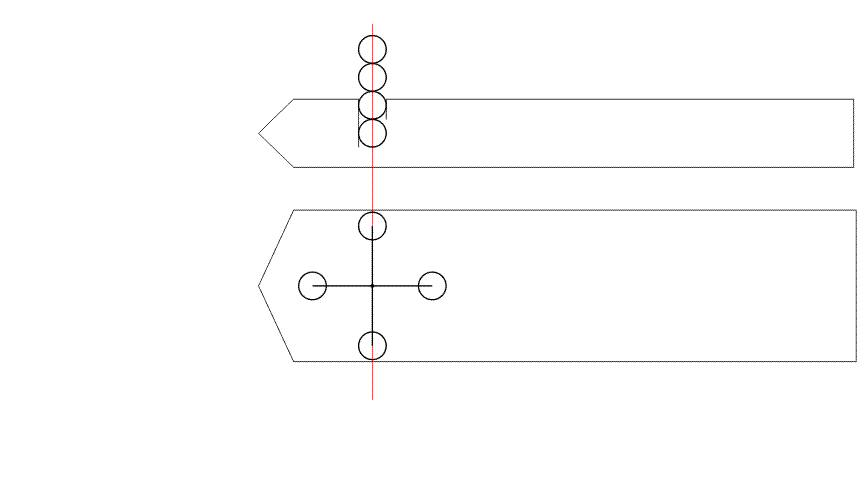
Fig. 6
After department, pellet they fly to the
moment of contact with the rear wall of flight vehicle.
The center of the masses of the "chain" of the pellets, which
were separated from the centrifuge (position of point
 to fig.5), is displaced relative to the center of
the masses of the pellets, which would be "shot off" (position of point
to fig.5), is displaced relative to the center of
the masses of the pellets, which would be "shot off" (position of point to fig.5).
to fig.5).
After connecting the flying pellets with the housing of
flight vehicle, the speed of housing will be equal to the initial velocity of
entire mechanical system, or, in this case, zero.
But the position of the center of the masses of entire system "housing -
load" we will be different for the different methods of the department of the
particles of the load.
Thus, the momentum of pellets both in the case of "shooting" and in the case
of separation from centrifuge - is equal.
In each stage of the department of pellets, the pulse of system (housing - the
"remained load") also has identical value.
But here is the position of the center of the masses of entire system at the
initial and end points of time - they are different. |
Graphical solution clearly shows that the center of the masses of mechanical
system, with the different methods of the separation of components, has
different coordinates. (solution not only is graphic.
To look the graphs of the displacement of components for
the conditions of specific objectives, is possible here.)
Thus, it is assumed that there is a possibility of displacing the closed
mechanical system due to the internal energy of system. With this displacement
the law of conservation of momentum is not disrupted.
The shift of the center of the masses of entire mechanical system occurs
during entire period of separation of the particles of the load from centrifuge.
The amount of displacement is proportional to a radius of centrifuge and to
the mass of load on the centrifuge.
It is possible to assume that the distance to the "rear wall of flight
vehicle" is equal to zero, i.e., the particles of load fly "zero" distance.
The displacement of a similar mechanical system is represented to
fig.7
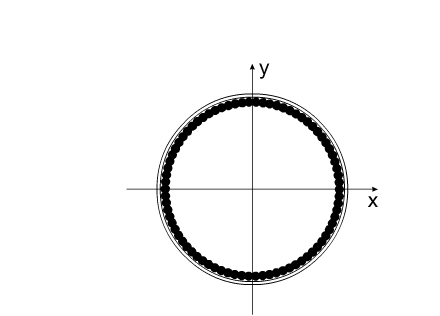
Fig. 7
Blue track the movement of the body(case).
Red - moving center of mass of the all system.
You can look the mathematical calculations, which describe this
assumed phenomenon, with the address:
https://varipend.narod.ru
S.Butov
ButovSV 12/04/2007
It is protected by the legislation of the
Russian Federation on the copyrights.
No part of the site can be reproduced in to any form and any means without
the written permission of the owner of the copyrights


|